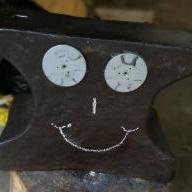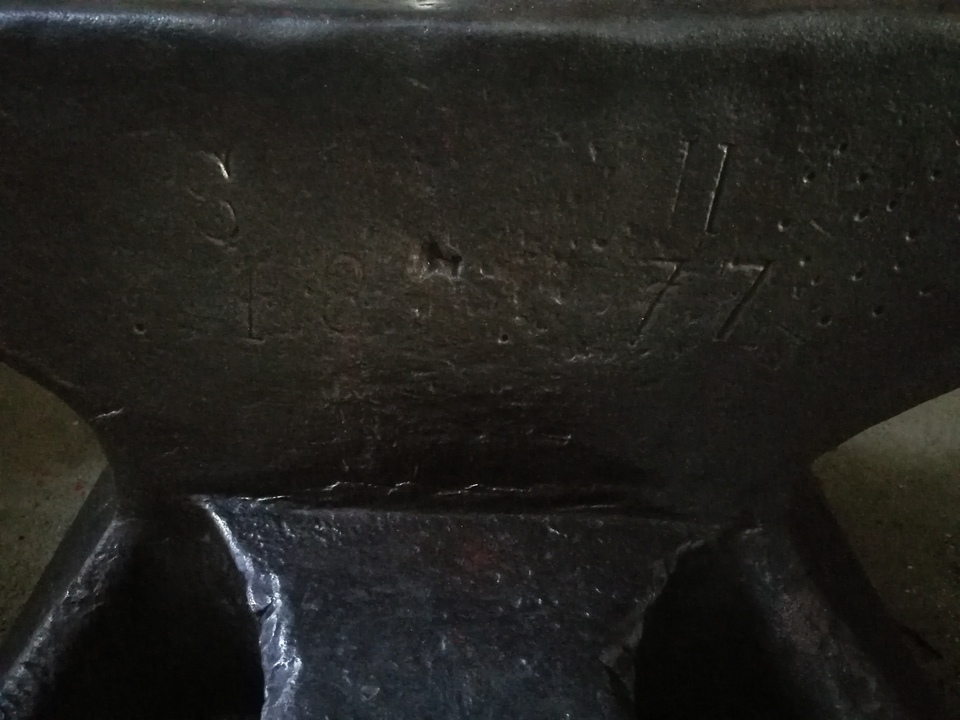-
Posts
75 -
Joined
-
Last visited
Content Type
Profiles
Forums
Articles
Gallery
Downloads
Events
Everything posted by Julianb
-
Hello! If you could provide a clearer picture of the stamped numbers, that'd be great. Is there any kilogram abbreviation marking next to the number? That could at least narrow it down a little, but if there's no other markings, you might never now who made that anvil. Cheers! Julian
-
Hello! A few months ago, I promised to find out the maker of the hammer with the C.D. marking inside a crown. Lo and behold, I finally have an answer: It is the company of "Carl Döhl", later "Carl Döhl Söhne", founded 1859 in Wuppertal Ronsdorf, Germany (the German chamber of industry and commerce published a note on the 100th anniversary of the company in 1959). They were purchased by Peddinghaus (yes, PFP) in 1963, according to the Peddinghaus 175 year anniversary brochure. They produced tools for sheetmetal work, blacksmithing, later on also for the ever growing automobile industry. I'll try to clean up my sheetmetal tools tomorrow and post some of them, if there's enough time, I own at least one hammer by Carl Döhl, I think. Cheers! Julian Oh no, made a mistake. It is not PFP that purchased the company, but Carl Daniel Peddinghaus. Same name, also tool industry, same geographical area, different company. Just mixed them up again, as happens so often... Ah, and now my posts have been merged, I'll try again to just mark the above as an edit.
-
That is absolutely correct, the plates depicting anvils are available for free on the website dealing with the encyclopaedia.
-
Hello, there won't be a "source" that will say "Square holes in anvils exist since year xy." You could do a very extensive research into historic depictions of anvils to be at least able to say that such holes exist at a certain point in time and to a certain amount. Anvils as a source are also not very reliable, as they are not properly datable and stamped or engraved dates don't provide a reliable date of manufacture, at least not on ones dated back to the pre-industrial age. In general, the research on anvils and their manufacture is extremely time-consuming. Why not concentrate the video on the bottom tools, there's at least a lot of archeological material to rely on. Better to downscale a bit, than risking adding more to the enormous amount of simply wrong information and being a multiplier of hearsay and myths. If you have any specific questions regarding anvil manufacture, you could also pm me directly, if you like. I'll try to find some publicly available sources from my pile as well, but might not be able to get to it in the nearest future. Cheers! Julian
-
Could you post a link to this ad? My attempts on reverse searching come up fruitless.
-
Well, thanks! Another thing on this patterns which can be confusing sometimes: even if this particular pattern is called "north-german", it doesn't necessarily have to be produced in northern Germany. For example the well known company of Söding & Halbach produced lots of regionally named patterns, while sitting in western Germany and there is no so called "west-german" pattern. They might have originally stemmed from the typical styles and attributes found in a particular region, but at that point those designations are made, they are available everywhere. Cheers! Julian
-
Well, I didn't do much and couldn't really help out anymore. I also might be totally wrong!
-
Hi, I definitely have seen this mark before and I'm pretty sure I have a tool or two with it somewhere. I am at a total loss about the maker though. I'll try to find out more about it! Cheers! Julian
-
Hello, you have a nice north-german pattern anvil there. The year of 1887 seems a feasible interpretation, as 1827 would be a bit early for such an anvil. Although dated, if there's no other markings, it's not really possible to determine a maker. I compared it to the lettering styles of the more known ones and cannot find any resemblances that point into a certain direction. There are a lot of examples of anvils from the 19th century, that have a date stamp and nothing else, though. No way to tie that to any specific manufacturer. Cheers! Julian
-
Hello, I wouldn't do anything about the chipped spot, it happens and wouldn't even be substantial for a guarantee claim at S&H. The other questions are kind of a question of faith. I'd go with a large enough wood-stump, my 222kg anvil rests firmly on one of those and it does not move. Just a light coating of oil on the face would prevent rust, but as you're using it every day, I suppose, that shouldn't be necessary anyway. Cheers! Julian
-
Honestly? For 500€ I would’ve passed on that one. Around here there‘s so much cheaper stuff to have, it is just a matter of patience. But hey, that is absolutely luxurious, compared to prices in the US.
-
Hello, this is a very late Söding & Halbach anvil, they sometimes didn't punch in their logo in between the numbers of the year during the last years of production, at least it seems this way. It is No. 58, South-German pattern with side shelf and upsetting block. If the price is right, buy it and take some more detailed pictures, please! Cheers! Julian Edit: And are you sure it is 1938 and not 1936? It certainly looks like an 8, but I cannot tell for sure, from the grainy zoomed in picture. That'd be very interesting, if it was made in 1938!
-
Hello, it is believed that the flat side is there to lay the anvil on its back and use the church windows as a kind of swage. No, they're not hardened. Cheers!
-

Please, help identify/date this anvil
Julianb replied to caotropheus's topic in Anvils, Swage Blocks, and Mandrels
Yes, it refers to the single horn, because it is partly flat and partly round, so two parts of horn in one, so to say. I think it’s necessary to make a difference between double horned anvils and anvils with a doublehorn. Thank you for the flowers, but I’m not nearly as knowledgeable as it somehow seems! But as I happen to live in Solingen, I’ll try to activate some contacts in the local museum to find out more about your pair of scissors. -

Please, help identify/date this anvil
Julianb replied to caotropheus's topic in Anvils, Swage Blocks, and Mandrels
Hello, the form of your anvil could be identified as "Dutch with a doublehorn". I quote a catalogue of S&H here, which lists this form as "Holländischer, ohne Brust, mit Doppelhorn". It could've been made anywhere around the late 19th up to early 20th century. I hope that helped at least a little. Cheers! -
Hello, looks like a Skoda made anvil. Goods is correct about the term of the "breast", although these smaller ones are often called "half-breast". This type is often referred to as "Austrian" or "Steyrisch" (City, river and region in Austria) - pattern, although they mostly come with stepped double feet, called "Doppelfüße", or even triple feet. The so called "Bohemian" pattern includes some decorative arches on the side of the breast. All in all, it is a common form of anvil from around that geographical area. Cheers! Julian
-
Hello, that is a Peddinghaus 125kg model of more recent manufacture. This type of stamp was the last before they were marketed under the "Ridgid" brand. Definitely not 1930s, but that doesn't matter qualitywise. Cheers! Julian
-
The question has been asked a long time ago, but maybe this is interesting nonetheless. I recently acquired an anvil made bei S&H in 1877. Attached is one very low quality picture, I'll add more, once I could move the anvil to its destination with better lightning conditions. Cheers! Julian
-
That's a great pattern, actually called "Dutch" pattern by S&H. The number could indicate the fire in which the anvil was forged, but I'm not that deeply into the proceedings at August Refflinghaus yet. Hurrah! Julian
-
Hello! this nice anvil could/should be made by F.W. Krägeloh, the partly visible makers mark points in this direction. Here's the logo in full, hosted by a pretty informative website with a nice accumulation of knowledge: https://museodellincudinedisanmartino.files.wordpress.com/2020/03/img_0297.jpg This particular design is not the "Bavarian", but so called "Saxon" pattern. The difference is the breast, that does not smoothely transition into the body on one side, but has two clearly cut of edges. The big "No. 4" is the number of the forge fire, which produced this anvil. Cheers! Julian
-
By the way, the Standard anvils of S&S were cast...
-
Hello, Just the letter S for Standard would be a novelty for me, of course my knowledge is limited. The large S could also be part of the markings punched by Sichelschmidt & Schlasse (who marketed some of their anvils under the term Standard) or Söding & Halbach. Both usually punched their brand logo in between those big letters (S&S not as regularly) and also their style of marking differs from your anvil, so it is probably something entirely different. But who knows, maybe something else will turn up? Edit: Are there any markings on the backside or on the upsetting block? Cheers! Julian
-

Sichelschmidt und Schlasse (Sickle smith and lock)
Julianb replied to Zozon's topic in Anvil Reviews by brand
The overall look and the fact, that S&S produced cast iron anvils with welded on steel plate since the 1930s, strongly suggest that. Of course, I still could be wrong. How's the cleaning process coming along, Zozon? -
Nice examples, thanks for sharing! The first one resembles pattern No. 85: Swiss-pattern with half-breast, upsetting block, one horn and side-shelf. Difference to the No. 85 depicted bei S&H is the upsetting block being on the opposite side of the breast. The other one is also one of their Swiss-patterns, but without a picture of the front/back and opposite side it is not clear to determine with number exactly.

